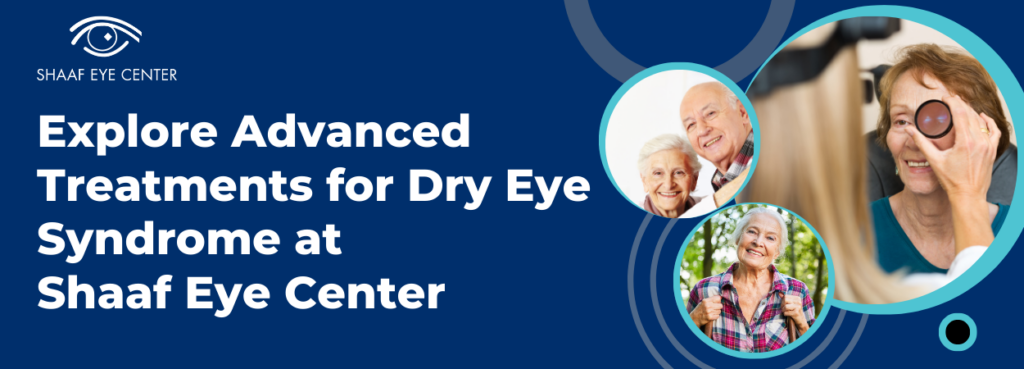
Ever feel like your eyes are constantly gritty, burning, or watering? You’re not alone. Millions of people suffer from dry eye syndrome, a condition that disrupts the eye’s natural lubrication system.
Here at Shaaf Eye Center, we understand how frustrating dry eyes can be. They can make it difficult to focus on work, read a book, or even enjoy a day outside. But the good news is, you don’t have to live with dry eye discomfort!

Dry Eye Causes:
There are several factors that can contribute to dry eye syndrome, including:
- Age: As we get older, our bodies produce fewer tears.
- Environmental factors: Dry air, wind, smoke, and staring at screens for long periods can all worsen dry eye symptoms.
- Medical conditions: Certain medical conditions, such as allergies, autoimmune diseases, and hormonal changes, can contribute to dry eyes.
- Medications: Some medications, such as antihistamines and antidepressants, can cause dry eyes as a side effect.
Dry Eye Diagnosis
Dry eye is diagnosed through a combination of patient history, symptom assessment, and various clinical tests performed by an eye care professional.
- Patient History and Symptoms: Patients report symptoms such as stinging, burning, scratchiness, or a sensation of something in the eye. A detailed medical history helps identify risk factors like age, medications, or medical conditions.
- Tear Film Break-Up Time (TBUT): This test measures how long it takes for tears to evaporate after a blink. A shorter TBUT indicates dry eye.
- Schirmer Test: Strips of paper are placed under the lower eyelids to measure tear production over a few minutes.
- Staining Tests: Special dyes (fluorescein or lissamine green) are used to highlight damage on the eye’s surface.
- Tear Osmolarity Test: Measures the salt concentration in tears, with higher levels indicating dry eye.
- Meibomian Gland Evaluation: The function of the meibomian glands, which produce the oily layer of the tear film, is assessed. Blocked or dysfunctional glands can lead to evaporative dry eye.
Dry Eye Treatment
At Shaaf Eye Center, we understand how challenging Dry Eye Syndrome can be. That’s why we offer advanced treatments to help you find relief and improve your eye health.
- Artificial Tears and Lubricants: Over-the-counter eye drops provide relief by supplementing natural tears.
- Prescription Medications: Anti-inflammatory drugs like cyclosporine (Restasis) or lifitegrast (Xiidra) can be prescribed to reduce inflammation and increase tear production.
- Lifestyle Changes: Taking breaks during screen time, using humidifiers, and avoiding smoke or wind can help.
- Punctal Plugs: Small plugs inserted into tear ducts reduce tear drainage, keeping eyes moist longer.
- Omega-3 Supplements: Dietary supplements may improve tear quality.
- Meibomian Gland Therapy: Warm compresses, eyelid massages, and devices like TearCare® help unblock and improve the function of meibomian glands.
Regular follow-ups are essential to monitor progress and adjust treatments as needed.
Don’t let Dry Eye Syndrome control your life. Take the first step towards relief and improved eye health today. Call Shaaf Eye Center at (760) 346-5005 to schedule your Dry Eye Evaluation. Our team of experts is here to help you find the best treatment options tailored to your needs.
Experience the difference at Shaaf Eye Center and enjoy the comfort of healthy, hydrated eyes once again.






